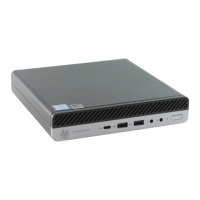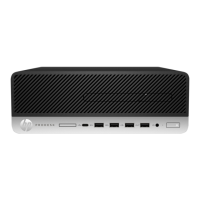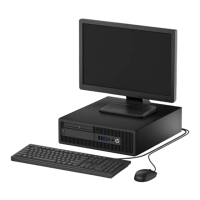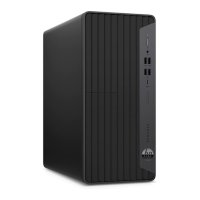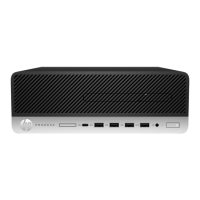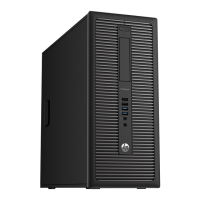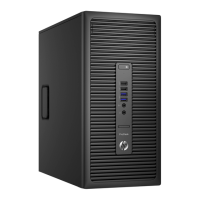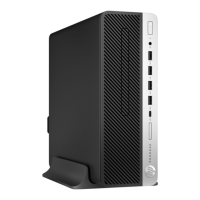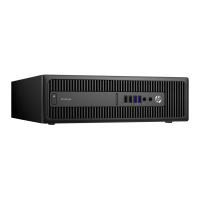Do you have a question about the HP ProDesk 600 G1 and is the answer not in the manual?
Overview of the computer's standard hardware and software features.
Details on the connectors and bays on the front of the Tower model.
Details on the connectors and bays on the front of the Small Form Factor model.
Identifies rear panel connectors for the Tower model.
Identifies rear panel connectors for the Small Form Factor model.
Explains where to find the computer's unique serial and product ID numbers.
Guides users through activating and customizing Windows 7.
Guides users through activating and customizing Windows 8.
Lists and identifies major components of the Tower chassis.
Lists various cables with their spare part numbers.
Lists miscellaneous computer components and their spare part numbers.
Explains the risks of ESD and how to prevent damage to components.
Provides instructions for safe and optimal computer operation.
Details general cleaning safety precautions and procedures for computer components.
Outlines initial safety procedures before disassembling the computer.
Instructions for removing the computer's access panel.
Explains how to install a security screw to lock the front bezel.
Steps for removing and replacing the front bezel of the Tower model.
Instructions for removing bezel blanks for drive bays.
Information on installing and configuring DIMMs and DDR3-SDRAM modules.
Guides on installing, removing, or replacing PCI Express expansion cards.
Identifies system board connectors and their labels.
Lists types of drives and their spare part numbers.
Illustrates and labels the different drive bays within the chassis.
Details on removing and replacing the front I/O assembly.
Instructions for removing and replacing the power switch and LED assembly.
Steps for removing and replacing the processor fan and heat sink assembly.
Guides on removing and replacing the computer's processor.
Instructions for removing and replacing the internal speaker.
Information on the Smart Cover Lock feature and obtaining a FailSafe key.
Steps for removing and replacing the hood sensor.
Instructions for removing and replacing the chassis fan.
Guides on removing and replacing the computer's power supply unit.
Instructions for removing and replacing the system board.
Outlines initial safety procedures before disassembling the SFF computer.
Instructions for removing the SFF computer's access panel.
Steps for removing and replacing the front bezel of the SFF model.
Explains how to install a security screw for the SFF front bezel.
Instructions for removing bezel blanks for SFF drive bays.
Information on installing and configuring DIMMs for SFF systems.
Guides on installing, removing, or replacing PCI Express expansion cards for SFF.
Identifies SFF system board connectors.
Lists optical and hard drive types for SFF with spare part numbers.
Illustrates and labels SFF drive bay locations.
Guides on removing and replacing the SFF power supply unit.
Instructions for removing and replacing the SFF fan duct.
Information on the SFF Smart Cover Lock feature.
Steps for removing and replacing the SFF hood sensor.
Image showing proper cable routing in the SFF computer.
Details on removing and replacing the SFF front I/O assembly.
Instructions for removing and replacing the SFF power switch assembly.
Instructions for removing and replacing the SFF internal speaker.
Steps for removing and replacing the SFF processor fan and heat sink assembly.
Guides on removing and replacing the SFF processor.
Instructions for removing and replacing the SFF system board.
Overview of the Computer Setup utility and its capabilities.
Guidelines for establishing a safe and comfortable work environment for computer use.
Steps to take to isolate problems before contacting support.
Common computer issues and their solutions.
Solutions for common display and monitor issues.
Troubleshooting steps for common printer issues.
Solutions for keyboard and mouse not working correctly.
Troubleshooting common network connectivity issues.
Common causes and solutions for computer memory issues.
Troubleshooting common processor performance issues.
Solutions for issues with CD-ROM and DVD drives.
Troubleshooting common issues with USB flash drives.
Solutions for problems with USB devices, headphones, or microphones.
Troubleshooting common issues connecting to the internet.
Solutions for common application and operating system issues.
Lists POST error codes, messages, and recommended actions.
Explains front panel LED codes and audible signals for diagnostics.
Steps to reset system passwords by clearing CMOS.
Procedure for clearing and resetting the computer's CMOS settings.
Explains the benefits of using HP's UEFI diagnostic tools.
Guides on accessing and running the UEFI diagnostic tool.
Information on safeguarding and recovering data in Windows 8.
Details on using Windows 8 recovery options like Refresh and Reset.
Steps for system recovery using created recovery media.
Information on safeguarding and recovering data in Windows 7.
Explains the Smart Cover Lock feature and how to obtain a FailSafe key.
Specifies general requirements for power cord sets used with the computer.
Lists physical and electrical specifications for the Tower model.
Lists physical and electrical specifications for the Small Form Factor model.
Overview of the computer's standard hardware and software features.
Details on the connectors and bays on the front of the Tower model.
Details on the connectors and bays on the front of the Small Form Factor model.
Identifies rear panel connectors for the Tower model.
Identifies rear panel connectors for the Small Form Factor model.
Explains where to find the computer's unique serial and product ID numbers.
Guides users through activating and customizing Windows 7.
Guides users through activating and customizing Windows 8.
Lists and identifies major components of the Tower chassis.
Lists various cables with their spare part numbers.
Lists miscellaneous computer components and their spare part numbers.
Explains the risks of ESD and how to prevent damage to components.
Provides instructions for safe and optimal computer operation.
Details general cleaning safety precautions and procedures for computer components.
Outlines initial safety procedures before disassembling the computer.
Instructions for removing the computer's access panel.
Explains how to install a security screw to lock the front bezel.
Steps for removing and replacing the front bezel of the Tower model.
Instructions for removing bezel blanks for drive bays.
Information on installing and configuring DIMMs and DDR3-SDRAM modules.
Guides on installing, removing, or replacing PCI Express expansion cards.
Identifies system board connectors and their labels.
Lists types of drives and their spare part numbers.
Illustrates and labels the different drive bays within the chassis.
Details on removing and replacing the front I/O assembly.
Instructions for removing and replacing the power switch and LED assembly.
Steps for removing and replacing the processor fan and heat sink assembly.
Guides on removing and replacing the computer's processor.
Instructions for removing and replacing the internal speaker.
Information on the Smart Cover Lock feature and obtaining a FailSafe key.
Steps for removing and replacing the hood sensor.
Instructions for removing and replacing the chassis fan.
Guides on removing and replacing the computer's power supply unit.
Instructions for removing and replacing the system board.
Outlines initial safety procedures before disassembling the SFF computer.
Instructions for removing the SFF computer's access panel.
Steps for removing and replacing the front bezel of the SFF model.
Explains how to install a security screw for the SFF front bezel.
Instructions for removing bezel blanks for SFF drive bays.
Information on installing and configuring DIMMs for SFF systems.
Guides on installing, removing, or replacing PCI Express expansion cards for SFF.
Identifies SFF system board connectors.
Lists optical and hard drive types for SFF with spare part numbers.
Illustrates and labels SFF drive bay locations.
Guides on removing and replacing the SFF power supply unit.
Instructions for removing and replacing the SFF fan duct.
Information on the SFF Smart Cover Lock feature.
Steps for removing and replacing the SFF hood sensor.
Image showing proper cable routing in the SFF computer.
Details on removing and replacing the SFF front I/O assembly.
Instructions for removing and replacing the SFF power switch assembly.
Instructions for removing and replacing the SFF internal speaker.
Steps for removing and replacing the SFF processor fan and heat sink assembly.
Guides on removing and replacing the SFF processor.
Instructions for removing and replacing the SFF system board.
Overview of the Computer Setup utility and its capabilities.
Guidelines for establishing a safe and comfortable work environment for computer use.
Steps to take to isolate problems before contacting support.
Common computer issues and their solutions.
Solutions for common display and monitor issues.
Troubleshooting steps for common printer issues.
Solutions for keyboard and mouse not working correctly.
Troubleshooting common network connectivity issues.
Common causes and solutions for computer memory issues.
Troubleshooting common processor performance issues.
Solutions for issues with CD-ROM and DVD drives.
Troubleshooting common issues with USB flash drives.
Solutions for problems with USB devices, headphones, or microphones.
Troubleshooting common issues connecting to the internet.
Solutions for common application and operating system issues.
Lists POST error codes, messages, and recommended actions.
Explains front panel LED codes and audible signals for diagnostics.
Steps to reset system passwords by clearing CMOS.
Procedure for clearing and resetting the computer's CMOS settings.
Explains the benefits of using HP's UEFI diagnostic tools.
Guides on accessing and running the UEFI diagnostic tool.
Information on safeguarding and recovering data in Windows 8.
Details on using Windows 8 recovery options like Refresh and Reset.
Steps for system recovery using created recovery media.
Information on safeguarding and recovering data in Windows 7.
Explains the Smart Cover Lock feature and how to obtain a FailSafe key.
Specifies general requirements for power cord sets used with the computer.
Lists physical and electrical specifications for the Tower model.
Lists physical and electrical specifications for the Small Form Factor model.
| Tcase | 66.4 °C |
|---|---|
| Bus type | DMI |
| Stepping | C0 |
| FSB Parity | No |
| Processor cache | 3 MB |
| Processor cores | 2 |
| Processor model | i3-4160T |
| System bus rate | 5 GT/s |
| Processor family | Intel® Core™ i3 |
| Processor series | Intel Core i3-4100 Desktop series |
| Processor socket | LGA 1150 (Socket H3) |
| Processor threads | 4 |
| Processor codename | Haswell |
| Number of QPI links | 0 |
| Processor frequency | 3.1 GHz |
| Processor cache type | Smart Cache |
| Processor lithography | 22 nm |
| Processor manufacturer | Intel |
| Processor front side bus | - MHz |
| PCI Express slots version | 3.0 |
| Processor operating modes | 64-bit |
| ECC supported by processor | Yes |
| PCI Express configurations | 1x16, 2x8, 1x8+2x4 |
| Thermal Design Power (TDP) | 35 W |
| Number of processors installed | 1 |
| Maximum number of PCI Express lanes | 16 |
| Memory types supported by processor | DDR3-SDRAM |
| Memory clock speeds supported by processor | 1333, 1600 MHz |
| Memory bandwidth supported by processor (max) | 25.6 GB/s |
| Maximum internal memory supported by processor | 32 GB |
| Memory slots | 2x SO-DIMM |
| Internal memory | 4 GB |
| Memory channels | Dual-channel |
| Memory clock speed | 1600 MHz |
| Maximum internal memory | 16 GB |
| Memory layout (slots x size) | 1 x 4 GB |
| HDD size | 2.5 \ |
| HDD speed | 7200 RPM |
| Storage media | HDD |
| Total storage capacity | 500 GB |
| Intel segment tagging | Enterprise, Small Business |
| On-board graphics card ID | 0x41E |
| Discrete graphics card model | Not available |
| On-board graphics card model | Intel® HD Graphics 4400 |
| On-board graphics card family | Intel® HD Graphics |
| Maximum on-board graphics card memory | 1.7 GB |
| On-board graphics card base frequency | 200 MHz |
| On-board graphics card DirectX version | 11.1 |
| On-board graphics card dynamic frequency (max) | 1150 MHz |
| Number of displays supported (on-board graphics) | 3 |
| Bundled software | Adobe® Flash® Player\\r Bing search\\r Box\\r Buy Office\\r Computrace (status tracing)\\r CyberLink Power DVD, BD\\r CyberLink Power2Go (secure burn)\\r HP Client Security\\r HP Device Access Manager\\r HP Disk Sanitizer, External Edition\\r HP Drive Encryption\\r HP ePrint driver\\r HP File Sanitizer\\r HP PageLift\\r HP Recovery Disk Creator\\r HP Recovery Manager\\r HP Secure Erase\\r HP Support Assistant\\r HP Wireless Hotspot\\r Microsoft Defender\\r Microsoft Security Essentials\\r PDF Complete Corporate Edition\\r Skype |
| Operating system installed | Windows 7 Professional |
| Wi-Fi | - |
| USB 2.0 ports quantity | USB 2.0 ports have a data transmission speed of 480 Mbps, and are backwards compatible with USB 1.1 ports. You can connect all kinds of peripheral devices to them. |
| Chassis type | Mini Tower |
| Product color | Black |
| Country of origin | China |
| Audio system | DTS Sound+ |
| Product type | Mini PC |
| Motherboard chipset | Intel® Q85 |
| Scalability | 1S |
| Processor code | SR1PH |
| Processor ARK ID | 77489 |
| Processor package size | 37.5 x 37.5 mm |
| Supported instruction sets | AVX 2.0, SSE4.1, SSE4.2 |
| Thermal solution specification | PCG 2013A |
| Intel Secure Key Technology version | 1.00 |
| Intel Stable Image Platform Program (SIPP) version | 0.00 |
| Power supply input voltage | 230 V |
| Operating temperature (T-T) | 10 - 35 °C |
| Operating relative humidity (H-H) | 10 - 90 % |
| Sustainability certificates | ENERGY STAR |
| Depth | 177 mm |
|---|---|
| Width | 175 mm |
| Height | 34 mm |
| Weight | 1300 g |
